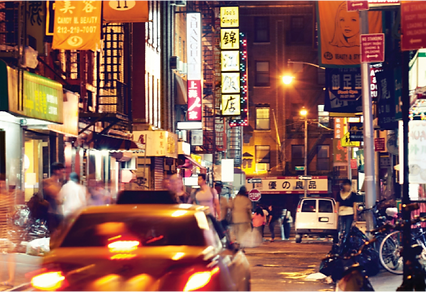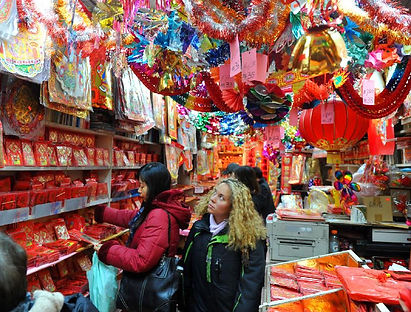Manhattan Chinatown
A Guide for Tourists
After learning about the history, crime, food and various shops in Manhattan’s Chinatown, a look into its present day culture and attractions will help explore the prevalent cultural traditions around its historical yet innovated streets. In the area south of Broome Street and east of Lafayette you’ll feel as though you’ve entered not just a different country but a different continent. Mott and Grand Streets are lined with stands selling exotic foodstuffs such as live eels, square watermelons and hairy rambutans, while Canal Street glitters with cheap jewelry, garden gnomes, trinkets and gift shops. With restaurants representing the cuisine of virtually every province of mainland China and Hong Kong, plus Indonesian, Malaysian, Thai and Vietnamese eateries and shops, present day Chinatown embodies not only China but many other Asian countries as well. With a population estimated between 70,000 and 150,000, Chinatown is the favored destination point for Chinese immigrants, though in recent years the neighborhood has also become home to Dominicans, Puerto Ricans, Burmese, Vietnamese, and Filipinos among others (History).
As Chinatown—New York City's largest Asian community—continues to grow and expand, merging with neighboring Little Italy and the Lower East Side. In a real sense, it can be said that the center of Chinatown is no longer on Mott St. between Canal St. and Chatham Square, but has moved further north and east to East Broadway and Grand St. between the Bowery and Chrystie St. The buildings in Manhattan’s Chinatown today are the same buildings built throughout the 18th and 19th centuries like much of New York City. Even with the historic architecture around the area, rent on some of the apartments and store fronts in Chinatown are some of the highest rates in the city due to their new building of luxury housing throughout their community. The buildings in Chinatown are now tightly packed, the old with the new, but the blocks have expanded to add more room for the constantly growing area, still a prevalent and well-known home to the majority of Chinese immigrants and a key neighborhood for tourists all over the world. (History)
Conclusions: Present Day Chinatown and Culture


Shop in present day Manhattan's Chinatown selling Chinese Lunar New Year decorations.
Streets of Manhattan's Chinatown as presently seen in the 21st century.
Culture – Places to See
To gain further cultural insights, the Museum of Chinese in America (MOCA) is a noteworthy destination and the number one spot to begin exploring Manhattan’s Chinatown and its past in more depth. MOCA was founded as a community-oriented organization in 1980 by Jack Tchen, Charlie Lai and Chinese American artists, historians and students who felt that the memories of first-generation "old-timers" would be forgotten and lose without oral history, photo documentation, research, and collecting efforts. MOCA gathers and documents the personal stories of Chinese-Americans, communicating their traditions, struggles and achievements, exploring Chinese-America within the context of American history and culture yet still allowing people to see it with a critical perspective. MOCA captures and explores the various places of origin for Chinese-Americans and immigrants and their connections to families and homelands throughout the world. In 2009, MOCA moved to 215 Centre Street and was remodeled by renowned artist Maya Lin, increasing the museum’s size six-fold and displaying a true national center presenting the Chinese-American’s story and perspective as a central part of the American story. “Through its thought-provoking work, the Museum not only encourages the understanding and appreciation of Chinese-American arts, culture and history, but also informs, educates and engages visitors about Chinese-American history that is in the making. MOCA continues to be a platform for cultural dialogue: a self-renewing exchange that brings to life the multiple journeys, memories and contributions of the past and present, woven into a collective narrative that shapes the future of our Chinese-American legacy.” (About)
The interior of the museum is inspired by traditional Chinese homes, with rooms
radiating off a central courtyard and areas being encased and sculpted with paper screens. Mixed-media displays trace the development of industries, such as laundries and restaurants, in New York, Chinese stereotypes in pop culture and the suspicion and humiliation Chinese-Americans endured during World War II and the McCarthy era. There is also a gallery devoted to temporary exhibitions, rotating with works of contemporary Chinese-American artists. (About)

While strolling further along the streets of Chinatown, Columbus Park can be seen as an excellent place to relax and people-watch where early in the mornings, as the sun is rising, people practice their tai-chi or simply meditate. At special moments you can catch a glimpse of groups of women practicing the traditional Chinese fan dances as well. The park is usually always packed with groups of senior citizens playing cards or Chinese chess, and on weekends several groups of performers practicing traditional Chinese music or teenagers playing basketball (Things). Walking further towards the center, you’ll arrive near Chatham Square where there is a statue of Lin Zexu, a Chinese scholar who opposed the opium trade in the 19th century. There is also the Lieutenant Benjamin Ralph Kimlau Memorial Archway that was built in 1962 for Chinese-Americans who died in World War II. The memorial is decorated with calligraphy by the great Yu Youren 于右任. The statue of Confucius in front of Confucius Plaza is also a prominent landmark in Manhattan’s Chinatown, a common meeting place since 1976 when it was first built (New York Chinatown).
The original Chinatown Ice Cream Factory, the Mahayna Buddhist Temple and Winnie's karaoke bar are some other top places to visit in Chinatown for a more cultural experience. However, on the more artistic side, Chinatown had many significant Chinese theaters in the past that provided entertainment to the Chinese immigrant population. Among the theaters that existed in Chinatown in later years were the Sun Sing Theater, the Pagoda Theater , the Governor Theater, the Rosemary Theater and the Music Palace. Many, if not all, Chinese theaters also played movies with Chinese and English subtitles attracting many non-Chinese viewers to the area over the years. However, during the 1970s, the Chinese theaters became less popular due to growing gang-violence and crime in the Chinatown streets especially during the nights. With the convenience of videotapes, DVDs and VCDs and the Chinese cable channels, karaoke bars and gambling in casino, many theaters went out of business and closed down as seen today with other numerous options for entertainment becoming available. (New York Chinatown)



Official NYC Information Kiosk–Chinatown: The street phone booths are capped with pagoda-like decorations capturing an aspect of traditional Chinese architecture.
Streets of Manhattan's Chinatown

The statue of Confucius in front of Confucius Plaza is also a prominent landmark in Manhattan’s Chinatown, a common meeting place since 1976 when it was first built (New York Chinatown).
Festivals and Events
While in Manhattan’s Chinatown, festivals and events occurring throughout the year provide tourists an unique first-hand experience to feel immersed in Chinese culture and traditions.
(Double click on the pictures below in order to read the full captions)
Present Day
For a long time now, Manhattan's Chinatown has always been representative of Chinatowns in the U.S. and of one of the most largely concentrated Chinese population in New York City with overall 6% Chinese American (Chinatown). Unlike most other urban Chinatowns, Manhattan's Chinatown is both a residential area as well as commercial area full of history, culture and voices from the past and present. It beautifully perserves the historical and traditional aspect of the area with the modern aspect of NYC surrounding it, making it unique with overflowing culture. The area has maintained its bond to homeland China creating a sense of authenticity for visitors and residents that is unique to Manhattan's Chinatown and makes it successful as one. Manhattan’s Chinatown engaged tourists and nearby residents in an ongoing historical dialogue, in which people of all backgrounds are able to relate and see American history from a Chinese immigrant’s perspective, to introspect from their own experiences and make meaningful connections between the past and the present, the global and the local, their nationality and origins and, overall, themselves and others.
WORKS CITED:
"About." Museum of Chinese in America (MOCA). Web. 24 Feb. 2014.
.
"Chinatown, Manhattan." Wikipedia. Wikimedia Foundation, 03 Jan. 2014. Web. 24 Feb. 2014.
"Chinese Lunar New Year in New York City: 2014." About.com New York City Travel. Web. 25 Feb. 2014. .
"History of New York's Chinatown." The History of New York City's Chinatown. Web. 25 Feb. 2014. .
"New York Chinatown." Travel and Visitor Information. Web. 25 Feb. 2014. .
"Senator Squadron, Borough Parks Commissioner Castro, Community Leaders Announce Planting of Cherry Trees in Chinatown." New York State Senate. Web. 25 Feb. 2014.
"Things to See in Chinatown in New York." Travel Tips. Web. 25 Feb. 2014. .






